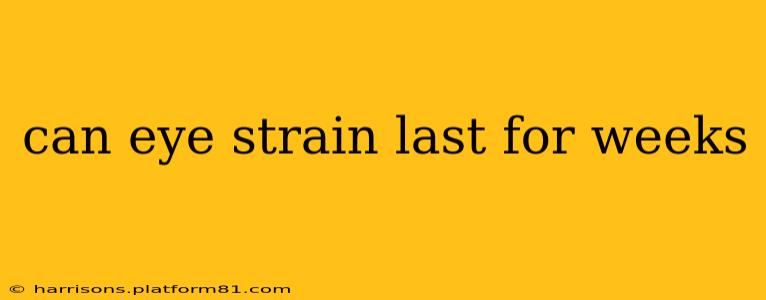Eye strain, that nagging discomfort in your eyes, is a common experience in today's digital world. While it usually fades within a day or two, the question many people ask is: Can eye strain last for weeks? The answer is yes, but it warrants attention. Persistent eye strain lasting for weeks isn't just an annoyance; it can signal an underlying issue requiring professional medical evaluation.
What Causes Prolonged Eye Strain?
Several factors can contribute to eye strain that lingers for an extended period. Understanding these causes is the first step to finding relief.
1. Excessive Screen Time:
This is perhaps the most common culprit. Hours spent staring at computers, smartphones, or tablets without breaks can lead to significant eye fatigue. The constant focusing on near objects tires the eye muscles, resulting in prolonged strain.
2. Uncorrected Refractive Errors:
Nearsightedness (myopia), farsightedness (hyperopia), and astigmatism can all significantly contribute to eye strain. If your vision isn't properly corrected with glasses or contact lenses, your eyes will constantly work harder to focus, leading to prolonged discomfort.
3. Dry Eyes:
Dry eye syndrome, characterized by insufficient tear production or poor tear quality, often causes persistent eye strain and discomfort. This can be exacerbated by prolonged screen time, air conditioning, and certain medications.
4. Underlying Medical Conditions:
In some cases, prolonged eye strain can be a symptom of a more serious underlying medical condition, such as:
- Migraines: Eye strain is a common migraine symptom.
- Thyroid Eye Disease (TED): This autoimmune disorder can cause inflammation and discomfort in the eye muscles and tissues.
- Diabetes: Diabetic retinopathy can lead to blurred vision and eye strain.
5. Poor Lighting and Ergonomics:
Improper lighting (too bright or too dim), incorrect monitor placement, and poor posture all contribute to eye strain that can persist for weeks.
How Long Can Eye Strain Last Before I Should See a Doctor?
While occasional eye strain is normal, persistent discomfort lasting for weeks or accompanied by other symptoms, such as:
- Blurred vision: Difficulty focusing or seeing clearly.
- Headaches: Frequent or severe headaches, often located around the eyes.
- Double vision (diplopia): Seeing two images of a single object.
- Eye redness or irritation: Persistent redness, itching, or burning sensation.
- Sensitivity to light (photophobia): Increased discomfort in bright light.
should prompt an immediate visit to an ophthalmologist or optometrist. These symptoms could indicate a more serious issue that needs professional attention.
What are the treatment options for prolonged eye strain?
Treatment depends on the underlying cause. For those caused by excessive screen time or poor ergonomics, simple adjustments might suffice:
- The 20-20-20 rule: Every 20 minutes, look at an object 20 feet away for 20 seconds.
- Regular breaks: Take frequent breaks from screen time.
- Adjust lighting: Ensure proper lighting to avoid eye strain.
- Improve posture: Maintain good posture while working.
- Artificial tears: Use artificial tears to lubricate dry eyes.
However, if underlying conditions like refractive errors or dry eye syndrome are involved, further intervention might be necessary, such as prescription glasses or contact lenses, specialized eye drops, or other medical treatments.
Can Eye Strain Cause Headaches?
Yes, eye strain is a common trigger for headaches, particularly tension headaches. The constant effort to focus and the resulting muscle fatigue in the eyes can lead to tension in the surrounding head and neck muscles, causing headaches.
How Can I Prevent Long-Term Eye Strain?
Prevention is key! By implementing the following strategies, you can significantly reduce your risk of experiencing prolonged eye strain:
- Regular eye exams: Get your eyes checked regularly, even if you don't experience any problems.
- Follow the 20-20-20 rule: This simple exercise can significantly reduce eye strain.
- Take breaks: Regularly step away from screens to rest your eyes.
- Blink frequently: Consciously blink more often to keep your eyes lubricated.
- Use proper lighting: Ensure adequate lighting while working or reading.
- Maintain good posture: Avoid hunching over your computer or phone.
- Adjust screen settings: Reduce screen brightness and adjust contrast for better comfort.
- Use blue light-filtering glasses: These glasses can help to reduce eye strain from digital devices.
Prolonged eye strain shouldn't be taken lightly. While often manageable with simple adjustments, persistent discomfort warrants a professional evaluation to rule out any underlying medical conditions. Remember, taking care of your eyes is crucial for maintaining overall health and well-being.
